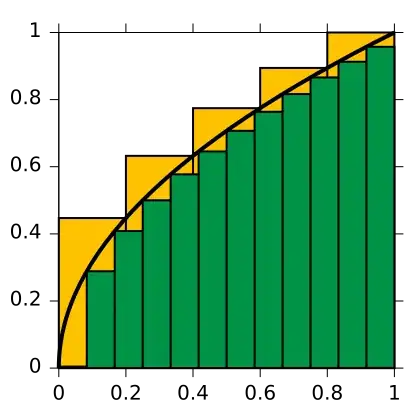I know I am late to the party, but while I see perfectly good answers to the question, I think it would be interesting to try to evaluate the integral which led to the question.
It must be noted that the integral in question is quite non-standard, because all integrals considered in mathematics take form of product with infinitesimal as one of its factors. There may be different ordering, such as $\int \mathrm{d}x f(x)$, and there may be various nesting and shorthand notations, but ultimately all integrals result from product with infinitesimal.
But, let's pretend we use non-standard analysis and integral given in question is valid. It was already correctly noted that the value would be finite, but actually it can be shown that:
$$\int (e^{\mathrm{d}x} - 1) = x$$
We will solve it by substituting $e^{\mathrm{d}x} - 1$ for something more useful. But where to find good substitution?
Let's recall using Leibniz's notation (d something is a very little bit of something, as Silvanus Thompson put) to take derivative of exponential function (that happens to be its own derivative):
$$e^x + \mathrm{d}e^x = e^{x+\mathrm{d}x}$$
$$e^x + \mathrm{d}e^x = e^xe^{\mathrm{d}x}$$
$$e^x + \mathrm{d}e^x = e^x\left(1+\mathrm{d}x\right)$$
$$\mathrm{d}e^x = e^x\mathrm{d}x$$
$$\frac{\mathrm{d}e^x}{\mathrm{d}x} = e^x$$
In the third step we invented a substitution $e^{\mathrm{d}x} = 1 + \mathrm{d}x$ to allow us to continue. While it led to finding the exponential function that is its own derivative and it can be used to find the value of $e$, it also allows us to evaluate the integral in question.
$$e^{\mathrm{d}x} - 1 = \mathrm{d}x$$
$$\int (e^{\mathrm{d}x} - 1) = \int {\mathrm{d}x} = x$$
But be careful with this.
First, such use of Leibniz's notation is not considered correct because of the notion of freely roaming infinitely small yet nonzero real numbers - that's the reason we use limits and epsilon-delta approach nowadays in calculus. If we still want to do the above trickery, it must be noted we are in the realm of non-standard analysis.
Second, while non-standard analysis may consider such integral valid (because it interprets integral as continuous sum) and evaluate it (as done above), it is still big question what that integral, as formulated, actually means and how it came to be.
Using known limits and identities we can also invent these non-standard integrals:
$$\int \sin{\mathrm{d}x} = x, \int \tan{\mathrm{d}x} = x$$
Obvious proof is left to the reader as an exercise. I also considered adding $\int (\cos{\mathrm{d}x} - 1) = 0$ to the list, but I am not sure about it when using infinitesimals that freely.
Disclaimer and opinion: I am not convinced about any sensible meaning and use of these integrals and I discourage their use. Using them may lead to confusion without any gain. The only result to me is some deep thinking about notation we use in math.
